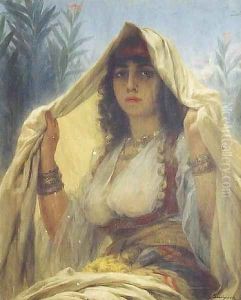Gaston-Casimir Saint-Pierre Paintings
Gaston-Casimir Saint-Pierre was a French painter born in 1833, whose work is often associated with the Academic and Orientalist movements, which were prominent in 19th-century European art. He is best known for his detailed and vibrant depictions of scenes from North African and Middle Eastern life, landscapes, and historical events, showcasing a fascination with exotic cultures that was common among European artists of his time. Saint-Pierre's work reflects the intricate details and rich colors that define the Orientalist aesthetic, capturing the imagination of his contemporaries and contributing to the romanticized view of the East that prevailed in Europe during the 19th century.
Saint-Pierre's artistic journey was nurtured in the prestigious art schools of France, where he honed his skills and developed a keen eye for detail and composition. His education and talent earned him recognition in the form of awards and commissions, allowing him to travel extensively, especially in North Africa, which became a primary source of inspiration for his art. His travels not only provided him with subjects for his paintings but also deepened his understanding of the cultures he portrayed, enabling him to infuse his works with a sense of authenticity and respect for his subjects.
Throughout his career, Saint-Pierre exhibited his works in various salons and exhibitions, gaining acclaim and the patronage of notable figures of his time. His paintings not only appealed to the artistic tastes of the public and collectors but also contributed to the broader cultural and political dialogues surrounding colonialism and cultural exchange between Europe and the regions depicted in Orientalist art. Despite the critical success and popularity he enjoyed during his lifetime, Gaston-Casimir Saint-Pierre, like many of his Orientalist contemporaries, has been subject to reassessment in the context of post-colonial studies, with scholars examining the implications of his work within the dynamics of power, representation, and the exoticization of the 'Other.'
Gaston-Casimir Saint-Pierre passed away in 1916, leaving behind a rich legacy of art that continues to be studied and appreciated for its technical mastery and historical value. His paintings reside in various art collections and museums around the world, serving as a testament to the enduring appeal of Orientalist art and providing insight into the complex interplay of culture, art, and imperialism that characterized the 19th century.




